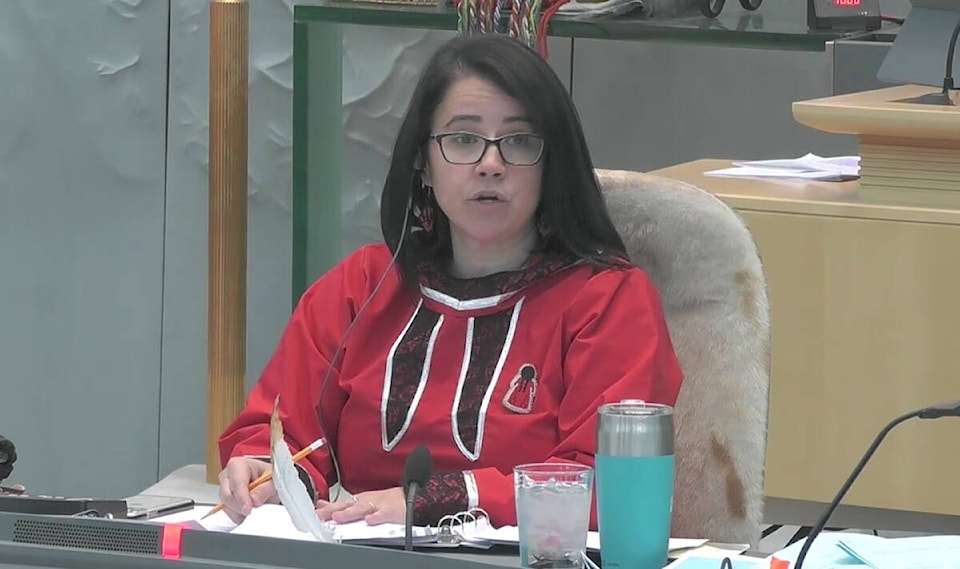A report on the GNWT’s 34-year-old affirmative action policy is now before cabinet, but in spite of pointed questions in the legislature, the GNWT is mum on if or when a new policy will be implemented.
Inuvik Twin-Lakes MLA Lesa Semmler and Yellowknife North MLA Ryland Johnson hammered Finance Minister Caroline Wawzonek on the subject during the Oct. 3 sitting of the legislative assembly.
“When this policy is approved and it is implemented, how long would the minister consider the timeline to be before we would start seeing the changes at the frontline?” asked Semmler. “Because every single one of us as MLAs — we all are MLAs first — have heard from our constituents on problems with hiring in the GNWT workforce. So when can this minister — when the policy comes into play — how long will it take for this government or the next government to have it roll out?”
Wawzonek replied that it is up to the executive council to review the GNWT’s ‘What We Heard’ report and make recommendations.
“It may be, Mr. Speaker, particularly given the timing, that we would want to delay implementation or we may want to make it, you know, a pilot or something that gives us a bit of breathing space, recognizing where we are in our timing and the challenges we’ve had this summer with timing,” Wawzonek told the legislature.
“With respect to a new policy, Mr. Speaker, the beauty of it being policy is that it will have some more flexibility. If there’s a new policy, typically what would happen is it does give an opportunity for departments and agencies to get used to it, to look at it, to refine it, to make sure that it is, in fact, the best one. So I can’t give a timeline for a thing that we haven’t announced.”
Johnson asked the minister if the GNWT is planning to go ahead with removing the Priority 2 candidate designation. Wawzonek said the GNWT has other options to ensure other visible minorities have a fair shot at government positions.
“The recommendation there really is, again, that the affirmative action policy is out of date, that it is inadequate, that this is unnecessarily complex,” said Wawzonek. “And coming from that, what was also contained in that report is that there be an Indigenous employment policy to offer priority hiring to Indigenous persons.
“That is an area where we all know that we have failed and continue to fail for 30 some years under this policy. It simply has not achieved its purpose or targets.
“With respect to a second employment policy, a broader employment policy, that’s not with the data it seems to suggest is required under Statistics Canada, certainly not an area that seems to be required in terms of looking at our own demographics as a public service,” the minister added. “And there are other tools already in place, such as the diversity and inclusion framework that might speak to it.”
Johnson pointed out the Standing Committee on Government Operations has presented four options for potential changes to the act. The first is to only hire Priority 1 candidates, which are Indigenous or Inuit persons born in the NWT. Another option was to strengthen the appeal process so it’s possible to overturn a job placement. A third was to guarantee a single administrative position in each department is a P1.
A last policy option was to push for decentralization of government departments, which would stimulate hiring P1s by hiring locally.
“It’s not rocket science,” he said. “If you want more Indigenous people in the public service, put the jobs where the Indigenous people are.
“You have to identify positions in headquarters, and you have to move them to communities.
“That is how you increase Indigenous people in the public service.”
The territorial government employs 17.2 per cent of the Indigenous labour force, according to the GNWT’s Indigenous Recruitment and Retention Framework document. The highest percentage is among Indigenous people with a university education — 56.4 per cent — while the lowest is those with no formal education: 3.1 per cent.
Fact file
Priority hiring
When the GNWT hires, people belonging to certain designated groups are given priority. The priority ranges from #1 (highest) to #4 (lowest). There are different priorities depending on the type of job.
For management and non-traditional jobs, the priorities are:
1a. Indigenous Aboriginal female persons
1b. Indigenous Aboriginal male persons
2. Resident women
3. Indigenous Non-Aboriginal persons or Resident Disabled persons
4. All other applicants
For all other jobs, the priorities are:
1. Indigenous Aboriginal persons
2. Indigenous Non-Aboriginal persons or Resident Disabled persons
3. All other applicants
Source: GNWT Human Resources website
